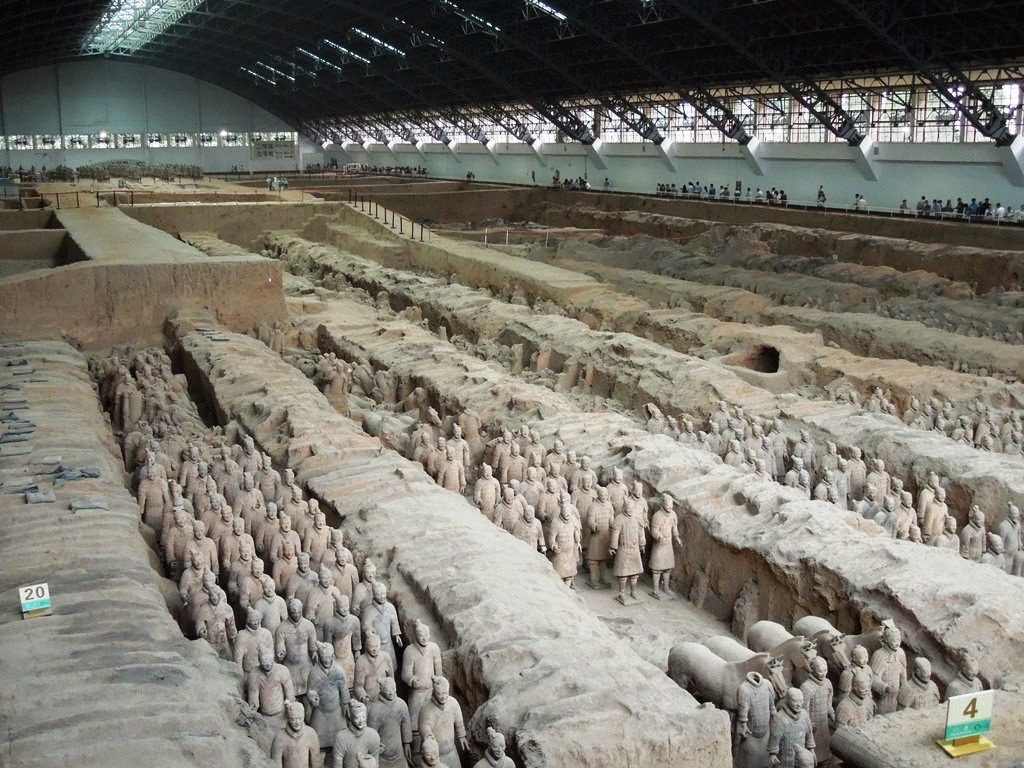The Army of Terracotta Warriors 兵马佣: of course you know what I'm talking about. Who hasn't heard of the Terracotta Army, those 8000 statues that stood guard of the tomb of the first emperor of China, the tyrant Qín Shĭ Huáng 始皇帝, remaining unknown to the outside world for more than 2000 years until they were discovered by farmers drilling for a well in 1974. It's been said many times that no two clay soldiers are alike. The Terracotta Army is definitely one of the world's premier archaeological sites, and you would be foolish to travel to Xī'ān 西安 and not make the effort to see it. We were not fools.
The scenery has changed somewhat since Qin Shi Huang's time
Hiring a driver for the morning and afternoon, we set off for the site outside the city. Like the Forbidden City and the Great Wall, the Army of Terracotta Warriors does not disappoint. Without further ado, I present you with the Emperor's tomb and his warriors:
We started off by checking out Pit 3, the smallest of the three vaults open for public viewing. It contains 72 warriors and horses, and apparently served as the field headquarters for the clay army.
Many of the statues had broken apart or had been decapitated, but were no less impressive.
Pit 2 was larger, with 1300 warriors and horses, but much of the vault is still encased in dirt, waiting to be excavated. Many of the figures were broken or smashed.
Five of the warriors are displayed in individual cases, giving visitors the chance to admire up close the astonishing craftsmanship and attention to detail. It should be noted that the soldiers were originally painted in bright colors, but the paint has almost all flaked off, with only traces remaining on some of the statues.
Weapons excavated from the tomb are also on display in Pit 2
Yang Shihua, one of the farmers who discovered the army, was supposedly on hand to autograph souvenir coffee table books. In China, you can never be too sure what (or who) is genuine. That didn't stop us from buying a book and having him sign it, however.
Finally, Pit 1 - the huge aircraft hanger housing upwards of 2000 soldiers. It was an amazing scene.
As you walk around the vault, you can see the army arrayed in formation as if it were preparing to go into battle, or to be reviewed by its sovereign.
By her own count, Amber took almost sixty pictures at the three vaults
Like the Forbidden City and the Great Wall, the Terracotta Army shows the Chinese fascination with large-scale projects requiring enormous amounts of human labor. Probably the most amazing fact about the warriors is that their existence was able to remain hidden from view for so long.
A pair of bronze chariots and their horses and drivers are on display in an adjacent museum.
After all that clay, it was time for lunch, washed down with a couple of bottles of Hans Beer, brewed locally in Xi'an under the auspices of the Tsingtao Brewery.
While the Army of Terracotta Warriors didn't fail to impress, the same couldn't be said of the Tomb of Qin Shi Huang 亲始皇陵. Located about 2 kilometers west of where the Terracotta soldiers were found, the mausoleum hasn't yet been excavated, meaning all there is to see is a small hill. Still, admission is free with the Terracotta Warrior ticket, so...
Pamela buys some pomegranates, a local specialty
Had we more had more time and better weather conditions, we could've rented some bicycles and ridden along the top of some of Xi'an's 14th-century Ming-dynasty city walls.
Back at the hotel and time for a quick dip in the (cold) swimming pool...
...then it was off in a three-wheeled motorized pedicab to Xi'an's Muslim Quarter for dinner.
Dinner was more an exercise in snacking as we feasted on kebabs, dumplings, quail eggs and ròujiāmó 肉夹镆, fried beef in pita bread.
Xiyang Shi Jie and Beiyuanmen were thronged with visitors checking out the action
The Drum Tower 鼓楼 (top) and Bell Tower 钟楼 (middle and bottom) were beautifully illuminated. Xi'an is a city that definitely looks better in the night light.
Walking back to the Sofitel, my wife had to stop for some stinky tofu 臭豆腐, which she inexplicably pronounced as being delicious.















































Umm...WOW! That is really amazing!
ReplyDeleteYou and Joe should try and make it out here before next July...
Delete